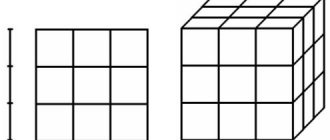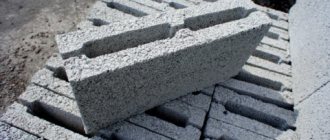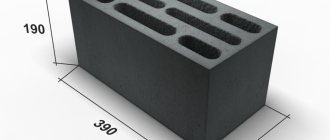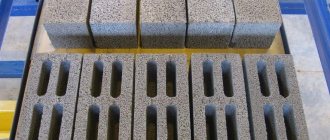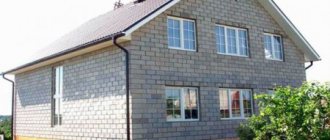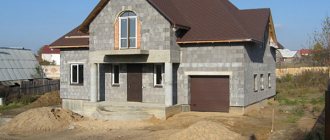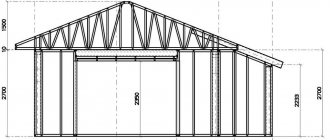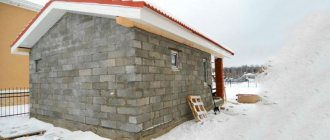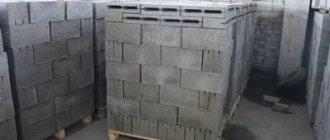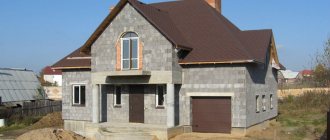- How many blocks are 600x300x200 mm in a square meter?
To build a house from aerated concrete blocks, you need to know how much aerated concrete is in 1 m² of masonry. This is necessary in order to buy the required number of pallets and know how much the construction will cost. Calculate the gas block per sq. m can be done in several ways, even without special engineering programs.
How to find out how many gas blocks are in 1 m²: initial data
To calculate the number of aerated concrete blocks in 1 square meter of masonry, the following initial data is needed:
- the height of the walls in the corners is usually 3 meters for a house, 2.5 meters for outbuildings;
- the dimensions of aerated concrete blocks depend on what material will be used;
- thickness of walls (masonry) - 1/2 block, 1-, 1.5 or 2 blocks.
- The thickness of the masonry joints depends on what the blocks will be placed on - glue or mortar.
To simplify the calculation, we assume that the masonry will be done with glue, and the thickness of the seams will be 2 mm. If a cement-sand mortar with a joint thickness of 10 mm is used, then you can find out how many aerated blocks are in 1 m² of masonry by applying the same calculation, but reducing the resulting number of blocks by 6%. With a DSP thickness of 15 mm, the number of blocks should be reduced by 9%, with 20 mm - 11%.
Expert opinion Vitaly Kudryashov builder, aspiring author
Ask a Question
Please note that by reducing the consumption of aerated concrete by thickening the masonry joints, you will not be able to save money. Seams are bridges of cold, and the larger their area, the more heat will escape from the walls of the house. To reduce heat loss, effective insulation will be required, the final cost of which will be more expensive than purchasing glue for thin-seam masonry.
Conclusion
Expanded clay concrete block has many advantages: low density, large dimensions, slight shrinkage after drying, and resistance to sudden temperature changes. In addition, even a child can hammer a nail into a wall made of expanded clay concrete, unlike brick.
Without correct calculations of building materials, no successful construction could begin. Therefore, you should not purchase everything at once; calculations according to the schemes we propose will not take much of your time and will allow you to save money. And a house made of expanded clay concrete will be durable, warm, quiet and will serve you for many years.
Types of gas blocks
Aerated concrete blocks have standard sizes, which are established by GOST 31360-2007. There are two main types of gas blocks: standard and U-shaped.
Standard aerated concrete blocks
Products with a rectangular cross-section with a thickness that is slightly less than its width.
| Length, mm | Height, mm | Thickness, mm |
| 600 625 | 200 250 | 200 250 300 350 375 400 500 |
GOST 31360-2007 allows minor deviations from the specified dimensions for gas blocks of the 1st category: length - plus/minus 3 mm, width - plus/minus 2 mm, height - plus/minus 1 mm. When calculating how much gas block is in 1 m² of masonry, these tolerances do not need to be taken into account.
Expert opinion Vitaly Kudryashov builder, aspiring author
Ask a Question
For building a house, materials with dimensions of 600x200x300 and 600x200x200 are most often used. It is important for them to know how many gas blocks are in a square meter.
U-shaped aerated concrete blocks
Products with a recess on the surface that runs parallel to the length. The recess is used for installation of communications, Mauerlat, and thermal insulation materials.
| Length, mm | Height, mm | Thickness, mm |
| 600 625 | 250 | 250 300 375 500 |
How many U-shaped aerated concrete blocks are there in 1 square meter? The calculation is carried out in the same way as for standard rectangular materials.
Tips for Building with Cinder Block
- Since this material gets wet very well, it is better to try to raise the foundation above the ground. As for the base, it needs to be well insulated;
- The ideal and simplest insulation for cinder block walls is a semi-liquid solution of cement and sand. We spray this “coat” on the walls using a large brush. After the first layer has dried, it is best to apply the second;
- The appearance of a cinder block is quite unsightly, so you need to take care of the exterior finishing. For this, siding or decorative brick can be used;
- If you want to achieve environmental friendliness, moisture resistance, as well as high insulating properties, then it is best to use expanded clay concrete. In it, slag is replaced with expanded clay, which significantly changes the properties of this building material;
- Many cinder blocks are made in a handicraft manner, since the raw materials for them are cheap, the manufacturing technology is simple, and brick presses are relatively affordable. It is not possible to check the quality of such products and what they are made of. So, it is best to buy cinder blocks from large sellers.
Methods for calculating the number of gas blocks (per 1 m²)
Calculation of aerated block per sq. m is performed in the following ways:
- According to the drawing. A wall of 100 by 100 cm is drawn, taking into account the dimensions of the gas-block elements and the type of masonry. Then it is calculated how many gas blocks are in a square meter. This is the simplest method and requires only a calculator, a pen and a piece of paper. To obtain the most accurate amount of material, do not go beyond 1 m², count half blocks if the dimensions in the drawing require it.
- Online calculator. You can find engineering calculators online that will help you quickly calculate how many gas blocks of 600x300x200 and other sizes are in a square meter.
- Using a table compiled by design engineers. The tables take into account the size of piece materials and the type of masonry. This is the simplest and most accurate method of calculation, allowing you to find out in a matter of seconds how many aerated concrete blocks are in a square meter.
How many blocks are 600x300x200 mm in a square meter?
| Aerated concrete 600x300x200 mm | ||
| Type of masonry in block | Quantity per 1m² | Wall thickness |
| ½ | 2 | 200 |
| 1 | 7 | 400 |
| 1.5 | 14 | 600 |
| 2 | 22 | 800 |
The table shows the calculation of the D400 gas block per sq. m, which is laid on glue with a layer thickness of 2 mm. The thickening of the wall due to the masonry joint is not taken into account. To determine the exact thickness, you need to add the thickness of the masonry joint to the indicated number.
How many gas blocks 600x200x200 mm per square meter
| Aerated concrete 600x200x200 mm | ||
| Type of masonry in block | Quantity per 1m² | Wall thickness |
| ½ | 2 | 200 |
| 1 | 10 | 400 |
| 1.5 | 21 | 600 |
| 2 | 33 | 800 |
The calculation in the table is for aerated concrete blocks D400, which are most often used for laying walls in the Moscow region.
How much stock should I add?
the developer must calculate the production and transport losses of the stone.
According to practical data, losses of wall stone during transportation depend on the strength of the product; for expanded clay concrete, 5% breakage is allowed.
In addition, you need to add at least 10% of the reserve for adjusting the stone to the dimensions of the wall, in total the minimum supply of material should be taken at least 15%.
Such calculations are allowed for the simplest rectangular wall shapes, and if the cottage structure has various architectural components, then accurate calculations can only be performed using a software package. It is quite difficult to manually calculate the volumes of cornices, projections, columns and other parts.
What is the price of gas blocks with quadrature calculation
As a rule, gas blocks are not sold with quadrature calculations. You can buy aerated concrete individually or in pallets. How many gas blocks are placed on a pallet depends on their size.
Amount of aerated concrete on a standard pallet:
- 600x300x200 - 50 pcs or 1.8 m³;
- 600x200x200 - 75 pcs or 1.68 m³.
Knowing the area of the masonry (length x height of the walls) and how many aerated concrete blocks are in 1 square meter, you can easily calculate the required number of pallets. To calculate the cost of an aerated block for construction, the price of 1 pallet should be multiplied by their number.
Possible mistakes
The most common errors, which are typical for all calculation methods, appear when the developer incorrectly enters the initial data: on the size and type of building stone, on external/internal walls and gables, as well as on the height of wall structures.
Incorrect initial data accordingly lead to errors in calculating the perimeter, area and volume of wall material. In addition, developers often do not take into account the volume of technological openings and gables in their calculations.
In order to minimize such errors, when performing calculations, you will need to carefully check all the initial data on the design drawings of the house, pay attention to the external dimensions of the walls, which may be indicated with additional finishing or a heat-insulating layer
Calculation of aerated block per 100 sq.m: simple and understandable algorithm
Task: calculate the amount of aerated concrete with the calculation of the quadrature, as well as how many pallets are needed to lay 100 m² of wall. For construction, aerated block 600x300x200 mm is used, the type of masonry is 1.5 blocks.
- Using the table, we determine how many 600x300x200 pieces of gas block are in a square meter - 14 pieces.
- We determine the number of blocks per 100 sq.m - 140 pcs.
- We calculate the required number of pallets, taking into account how many blocks are in one pallet - 2 pallets + 40 pieces. Knowing the cost of a pallet, you can calculate the costs of constructing load-bearing walls and interior partitions.
Using the algorithm, you can easily calculate how many aerated concrete blocks are needed to lay a certain square footage. It is recommended to add +5% to the obtained data for technological losses.
Thus, you can accurately calculate how much aerated concrete is needed and how much construction will cost. When calculating the square footage, do not forget to take into account the openings for windows and doors.
Wall building blocks
Not so long ago, a brick house was considered a sign of great wealth of its owners. Nowadays, practicality and pragmatism come first when choosing building materials. Building blocks meet these requirements like no other material. They can be used not only in the construction of external walls, but also for partitions and interior walls.
What are the advantages of building blocks?
- Firstly, everyone is attracted by the short construction time and the absence of the need for special equipment.
- Secondly, building blocks are famous for their thermal insulation and durability. Those. Compared to brickwork, reducing the cost of insulation will significantly save construction costs. And the strength of building blocks gives block buildings a higher durability compared to wooden buildings.
For reference: the cost of finished walls is approximately 1/3 of the cost of the entire building!
Building blocks can be natural or artificial. The former are used mainly for finishing facades. Artificial building blocks are divided into expanded clay concrete blocks, PShchS blocks (based on a sand-crushed stone mixture), also popularly called cinder blocks, aerated concrete, foam concrete, polystyrene concrete, ceramic, wood concrete and many others.
Each of them is used depending on their advantages and disadvantages. For example, aerated concrete has good thermal insulation compared to expanded clay concrete, but it is inferior in strength.
As much as we would like to, unfortunately, an ideal material has not yet been invented that would simultaneously have low thermal conductivity, high strength, low weight and cost. Therefore, in each specific case it is necessary to choose the material that is suitable specifically for your building. But there is also good news. All blocks have one big advantage: they can be finished immediately after construction is completed, without waiting for drying and settling.
Source
